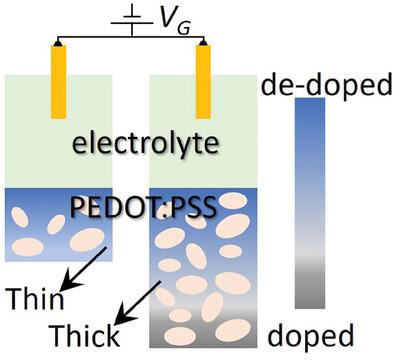当前位置:
X-MOL 学术
›
Adv. Electron. Mater.
›
论文详情
Our official English website, www.x-mol.net, welcomes your
feedback! (Note: you will need to create a separate account there.)
The Impact of Non‐Monolithic Semiconductor Capacitance on Organic Electrochemical Transistors Performance and Design
Advanced Electronic Materials ( IF 5.3 ) Pub Date : 2024-11-09 , DOI: 10.1002/aelm.202400373 Ned E. Dreamer, Dimitrios A. Koutsouras, Morteza Hassanpour Amiri, Paschalis Gkoupidenis, Kamal Asadi
Advanced Electronic Materials ( IF 5.3 ) Pub Date : 2024-11-09 , DOI: 10.1002/aelm.202400373 Ned E. Dreamer, Dimitrios A. Koutsouras, Morteza Hassanpour Amiri, Paschalis Gkoupidenis, Kamal Asadi

|
The existing device models for organic electrochemical transistors (OECTs) fail to provide any device design guidelines for optimized performance parameters such as transconductance that are pivotal for the applications OECTs in sensing. Moreover, the current models are based on the questionable assumption of a homogenous organic semiconductor layer, and all predict a linear behavior of the resistance with the OECT channel length. Consequently, the experimentally observed nonlinear resistance behavior in OECTs has been overlooked thus far. Here, an OECT device model is developed that accurately describes the nonlinear behavior of the OECT channel resistance and offers the first guidelines for maximizing transconductance. The model is inherently nonlinear and the nonlinearity stem from the non‐monolithic capacitance of the organic semiconductor layer. Moreover, the model provides a consistent and reliable estimations for the contact resistance in OECTs. The success of the model in accurately describing and providing predictions of the OECT operation by relating the device's geometrical parameters with electrochemical parameters of the semiconductor layer paves the way toward unlocking OECT potentials in diverse applications, from biosensing to neuromorphic computing and flexible electronics.
中文翻译:

非单片半导体电容对有机电化学晶体管性能和设计的影响
现有的有机电化学晶体管 (OECT) 器件模型无法为优化性能参数(如跨导)提供任何器件设计指南,而这些参数对于 OECT 在传感中的应用至关重要。此外,目前的模型基于均匀有机半导体层的可疑假设,并且都预测了电阻随 OECT 通道长度的线性行为。因此,到目前为止,实验观察到的 OECT 中的非线性电阻行为一直被忽视。本文开发了一个 OECT 器件模型,该模型准确描述了 OECT 通道电阻的非线性行为,并为最大化跨导提供了第一个指南。该模型本质上是非线性的,非线性源于有机半导体层的非单片电容。此外,该模型为 OECT 中的接触电阻提供了一致且可靠的估计。通过将器件的几何参数与半导体层的电化学参数相关联,该模型成功地准确描述和预测了 OECT 操作,为在从生物传感到神经形态计算和柔性电子学等各种应用中释放 OECT 的潜力铺平了道路。
更新日期:2024-11-09
中文翻译:

非单片半导体电容对有机电化学晶体管性能和设计的影响
现有的有机电化学晶体管 (OECT) 器件模型无法为优化性能参数(如跨导)提供任何器件设计指南,而这些参数对于 OECT 在传感中的应用至关重要。此外,目前的模型基于均匀有机半导体层的可疑假设,并且都预测了电阻随 OECT 通道长度的线性行为。因此,到目前为止,实验观察到的 OECT 中的非线性电阻行为一直被忽视。本文开发了一个 OECT 器件模型,该模型准确描述了 OECT 通道电阻的非线性行为,并为最大化跨导提供了第一个指南。该模型本质上是非线性的,非线性源于有机半导体层的非单片电容。此外,该模型为 OECT 中的接触电阻提供了一致且可靠的估计。通过将器件的几何参数与半导体层的电化学参数相关联,该模型成功地准确描述和预测了 OECT 操作,为在从生物传感到神经形态计算和柔性电子学等各种应用中释放 OECT 的潜力铺平了道路。


















































 京公网安备 11010802027423号
京公网安备 11010802027423号